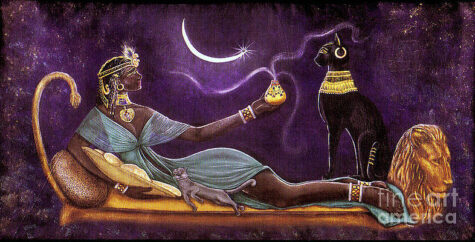The festival calendar of ancient Egypt, as it appears to us now, spans three thousand years of Egyptian history and probably was being recorded, observed, and manipulated many thousands of years before that. In those three millennia a great many political and religious changes affected the designated feast days. Some feasts fell out of favor, others were renamed, a few were entirely forgotten.
Many Egyptian feast days are moveable feasts, that is, they are lunar festivals timed to phases of the moon. Thus their occurrence might slip around from one year to the next. This is similar to how Easter Sunday, (the first Sunday following the first full moon after the vernal equinox), falls on a different date every year.
The Calendar
In any true sense it would be impossible for us to know the actual recurring dates of many of the festivals. We can, however, approximate the ancient dates. The Gregorian Calendar dates given here should not be taken as arbitrary or fixed, I think of them as a suggestion instead.
This particular calendar is from the book Feasts of Light. You may find that the dates of these various festivals are listed differently on other calendars. When planning a celebration in the Egyptian manner, use your intuition and your own understanding of the Lunar Calendar and the Wheel of the Year.
Season of Inundation – Akhet – Winter
During the Season of Inundation more major public festivals occurred than at any other time of the year, most of them related to fertility rites and abundance rituals. The feasts tended to occupy the general public during this time because the land was so flooded that little real work could be done.
Thuthi – The first month of winter
- 1 – The Rise of Sothis as Isis – July 19
- 1 – The Opening of the New Year – July 19
- 7 – The Feast of Anket – July 25
- 20 – The Inebriety of Hathor – August 7
Paopi – The second month of winter
- 5 – The Feast of Hathor and Min – August 22
- 15 – The Opet Festival – September 1
- 21 – Neith Goes Forth to Atum – September 7
Hethara – The third month of Winter
- 1 – Hathor’s Birthday Feast – September 17
- 17 – The Lamentations of Isis – October 3
- 21 – The Feast Day of Ma’at – October 8
- 30 – Opening the Bosom of Women – October 16
- 30 – The Feast of Isis in Busiris – October 16
Koiak – The fourth month of Winter
- 17 – The Plucking of the Papyrus for Hathor – November 2
- 27 to 29 – The Osirian Mysteries – November 12 to 14
- 27 – Isis Seeks the Body of Osiris – November 12
- 28 – Isis Grieves the Loss of Osiris – November 13
- 29 – Isis Rejoices as She Finds Osiris – November 14
Season of Sowing – Pert – Spring
Once the waters receded and work in the fields began, the Sowing season was the busiest time of the year.
Tybi – the first month Spring
- 19 and 20 – The Voyage of Hathor to Nubia – December 4 and 5
- 20 – Bast Goes Forth from Bubastis – December 5
- 28 to 30 – The Voyage of Hathor to Egypt and Her Father – December 13 to 15
Mechir – the second month of Spring
- 1 to 3 – The Voyage of Hathor to Egypt and Her Father( continued) – December 16 to 18
- 6 – The Feast of Isis the Black Cow – December 21
- 6 – The Festival of Raising the Djed of Osiris – December 21
- 10 – The Birth of Ra, Child of Nut – December 25
- 10 – The Birth of Horus, Child of Isis – December 25
- 19 – Isis Returns from Phoenicia with Osiris – January 3
- 21 – The Voyage of Hathor to See Her Seven Sisters – January 4
- 24 – Isis Greets Min in Coptos – January 8
Pamenot – the third month of Spring
- 5 – The Brilliant Festival of the Lights of Neith – January 19
Parmuti – the fourth month of Spring
- 20 – The Blessing of the Fleets by Isis – March 5
- 28 – Isis Births Horus the Younger – March 13
- 28 – Hathor Births Ihy – March 13
Season of the Harvest – Shemu – Summer
The growing season was quickly followed by the Harvest season. But during the final months of the year, when the harvest had ended and the land was dry, the festivals began again, mostly in anticipation of the coming Inundation.
Pachons – the first month of Summer
- 1 – The Feast of the Hand of the God – March 16
- 6 – The Pregnancy of Isis / Nut – March 21
- 15 – The Festival of Renenutet – March 30
- 19 – Isis Finds Osiris – April 3
Payni – the second month of Summer
- 1 – The Great Festival of Bast at Bubastis – April 15
- 26 – The Going Forth of Neith along the Water – May 10
Epiphi – the third month of Summer
- 1 – The Hierogamos of Hathor and Horus – May 15
- 4 – The Conception of Horus – May 18
- 5 – Hathor Returns to Punt – May 19
- 7 – The Sailing of the Gods after the Goddess – May 21
- 30 – The Festival of Mut: Feeding of the Gods – June 13
Mesore – the fourth month of Summer
- 3 – The Feast of Raet – June 16
- 3 – The Feast of Hathor as Sothis – June 16
The Epagomenal Days
The Egyptian year was divided into twelve months of thirty days each, which means that each year was about five days short of the astronomical year. To compensate for this difference, five extra days were added to the year, and (according to this particular calendar) are designated as follows:
- The Birthday of Osiris – July 14
- The Birthday of Horus the Elder – July 15
- The Birthday of Seth – July 16
- The Birthday of Isis (The Night of the Cradle) – July 17
- The Birthday of Nephthys – July 18
Krazelna: Day of Hekate
Krazelna: Day of Hekate
Krazelna: Day of Hekate
Rachel V Perry: Emancipation Day
Rachel: The Nemesia







Leave a Reply